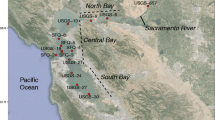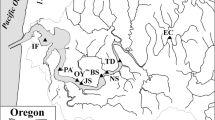Abstract
A method for measuring rates of nitrification in intact marine sediment cores has been modified and adapted for use in freshwater sediments. The technique involves subsampling a sediment core into minicores. Half of these cores are treated with an inhibitor of chemolithotrophic nitrification and, after incubation, differences in ammonia and nitrate concentration between inhibited and uninhibited systems are calculated. The within-treatment variability of ammonia and nitrate concentrations could be reduced by storing the cores overnight prior to subsampling. Estimates of the nitrification rate using the difference in ammonia concentrations between the inhibited and uninhibited mini-cores were always greater than the rate estimate using the difference in nitrate concentrations. Comparison between the results using the nitrification inhibitors allylthiourea (ATU) and nitrapyrin (N-Serve) indicated that the former appeared to give larger values for the nitrification rate than did the latter. Differences in the efficiency of these inhibitors in the control of nitrification under the conditions used partly explain these results. Data are also presented on the effect of N-Serve and ATU on some other nitrogen transformations affecting ammonia and nitrate concentrations.
Similar content being viewed by others
References
Belser LW, Schmidt EL (1980) Growth and oxidation kinetics of three genera of ammonia oxidising nitrifiers. FEMS Lett 7:213–216
Benschneider K, Robinson RJ (1952) A new spectrophotometric method for the determination of nitrite in sea water. J Mar Res 11:87–96
Billen G (1976) Evaluation of nitrifying activity in sediments by dark14C-bicarbonate incorporation. Wat Res 10:51–57
Bostrum B (1981) Factors controlling the seasonal variation of nitrate in Lake Erken. Int Revue Gesamten Hydrobiol 66:821–836
Bremner JM, Blackmer AM, Bundy LG (1978) Problems in the use of nitrapyrin (N-Serve) to inhibit nitrification in soils. Soil Biol Biochem 10:441–442
Campbell NER, Aleem MIH (1965) The effect of 2-chloro,6-(trichloromethyl)pyridine on the chemoautotrophic metabolism of nitrifying bacteria. I. Ammonia and hydroxylamine oxidation by Nitrosomonas. Antonie van Leeuwenhoek 31:124–136
Chen RL, Keeney DR, Konrad JG (1972) Nitrification in sediments of selected Wisconsin lakes. J Environ Qual 1:151–154
Christofi N, Preston T, Stewart WDP (1981) Endogenous nitrate production in an experimental enclosure during summer stratification. Wat Res 15:343–349
Crooke WM, Simpson WE (1971) Determination of ammonium in Kjeldahl digests of crops by an automated procedure. J Sci Fd Agric 22:9–10
Downes MT (1978) An improved hydrazine reduction method for the automated determination of low nitrate levels in freshwater. Wat Res 12:673–675
Ehlke TA (1978) The effect of nitrification on the oxygen balance of the upper Chattahoochee River, Georgia (USA). Report USGS/WRD/WRI-799/023, USGS/WRI-79-10. Order No PB-298347
Elgawhary SM, Iskander IK, Blake BJ (1979) Evaluation of nitrification inhibitors in cold regions land treatment of waste water. Part 1. Nitrapyrin. Report CRREL-SR-79-18-Pt-1. Order No AD-A071077
Focht DD, Verstraete W (1977) Biochemical ecology of nitrification and denitification. Adv Microb Ecol 1:135–214
Graetz DA, Keeney DR, Aspiras RB (1973) Eh status of lake sediment-water systems in relation to nitrogen transformations. Limnol Oceanogr 18:908–917
Hall GH (1982) Apparent and measured rates of nitrification in the hypolimnion of a mesotrophic lake. Appl Environ Microbiol 43:542–547
Hall GH, Collins VG, Jones JG, Horsley RW (1978) The effect of sewage effluent on Grasmere (English Lake District) with particular reference to inorganic nitrogen transformations. Fresh-wat Biol 8:165–175
Henninger NM, Bollag JM (1976) Effect of chemicals used as nitrification inhibitors on the denitrification process. Can J Micro 22:668–672
Henriksen K (1980) Measurement of in situ rates of nitrification in sediment. Microb Ecol 6:329–337
Henriksen K, Hansen JI, Blackburn TH (1981) Rates of nitrification, distribution of nitrifying bacteria, and nitrate fluxes in different types of sediment from Danish waters. Mar Biol 61:299–304
Hubley JH, Thomson AW, Wilkinson JF (1975) Specific inhibitors of methane oxidation in Methylosinus trichosporium. Arch Mikrobiol 102:199–202
Jeppesen E (1982) Application of the chlorate inhibition method in assessing potential nitrification in sediments from a lowland river and the nitrification semi in situ in undisturbed sediment by the use of continuous flow-through systems. In: Broberg A, Tiren T (eds) 9th Nordic symposium on sediment. Univ Uppsala, Inst Limnol, pp 46–71
Jones JG (1979) Microbial nitrate reduction in freshwater sediments. J Gen Micro 115: 27–35
Jones JG, Downes MT, Talling IB (1980) The effect of sewage effluent on denitrification in Grasmere (English Lake District). Freshwat Biol 10:341–359
Kenney DR (1980) Factors affecting the persistence and bioactivity of nitrification inhibitors. In: Nitrification inhibitors—potentials and limitations. American Society of Agronomy and Soil Science Society, America, pp 33–46
Matulewich VA, Finstein MS (1978) Distribution of autotrophic nitrifying bacteria in a polluted river (the Passaic). Appl Environ Micro 35:67–71
Montgomery HAC, Borne BJ (1966) The inhibition of nitrification in the BOD test. J Inst Sew Purif 65:350–368
Mortimer CH (1941) The exchange of dissolved substances between mud and water in lakes. J Ecol 29:280–329
McElhannon WS, Mills HA (1981) Suppression of denitrification with nitrapyrin. Hort Sci 16:530–531
Notton BA, Watson EF, Hewitt EJ (1979) Effects of N-Serve (2-chloro-6-(trichloromethyl) pyridine) formulations on nitrification and loss of nitrate in sand culture experiment. Plant and Soil 51:1–12
Ohnstad FR, Jones JG (1982) The Jenkin surface-mud sampler. User manual. Freshwater Biological Association. Occasional Publication No 15
Revsbech NP, Jorgensen BB, Blackburn TH (1980) Oxygen in the sea bottom measured with a microelectrode. Science 207:1355–1356
Slayton JL, Trovata ER (1980) Simplified NOD determination. Proc Indst Waste Conf 34th 868–886
Somville M (1978) A method for the measurement of in situ nitrification rates in water. Wat Res 12:843–848
Takahashi M, Yoshioka T, Saijo Y (1982) Nitrogen metabolism in lake Kizaki, Japan. 111. Active nitrification in early summer. Arch Hydrobiol 93:272–286
Vincent WF, Downes MT (1981) Nitrate accumulation in aerobic hypolimnia: relative importance of benthic and planktonic nitrifiers in an oligotrophic lake. Appl Environ Micro 42: 565–573
Young JC (1973) Chemical methods for nitrification control. J Wat Pollut Contrl Fed 45:637–646
Author information
Authors and Affiliations
Rights and permissions
About this article
Cite this article
Hall, G.H. Measurement of nitrification rates in lake sediments: Comparison of the nitrification inhibitors nitrapyrin and allylthiourea. Microb Ecol 10, 25–36 (1984). https://doi.org/10.1007/BF02011592
Issue Date:
DOI: https://doi.org/10.1007/BF02011592




